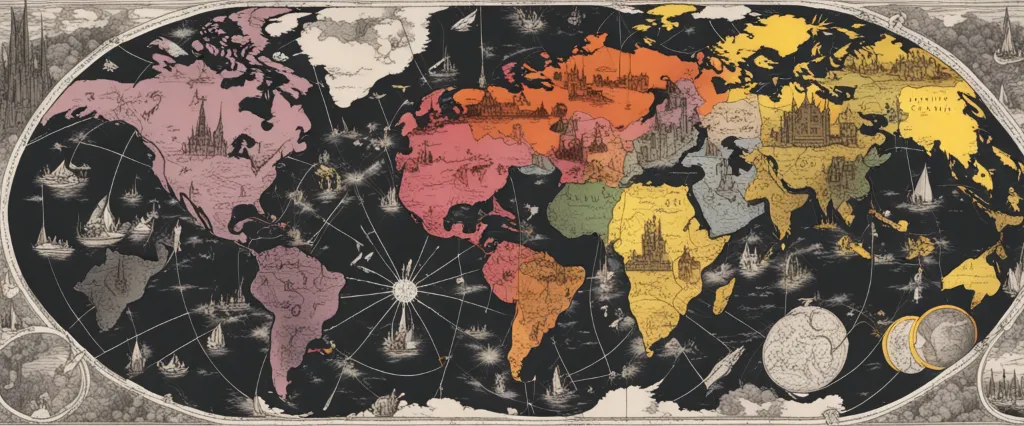
In his compelling book, “1493: Uncovering the New World Columbus Created,” acclaimed journalist and author Charles C. Mann ventures beyond the well-known events of Christopher Columbus’s voyage. With meticulous research and captivating storytelling, Mann unravels the far-reaching consequences of Columbus’s arrival in the Americas and the global transformations that ensued. Shedding light on the powerful intercontinental exchange that was set in motion, Mann reveals a vibrant and complex tapestry of human and ecological interactions. Through his thorough exploration, readers gain a deeper understanding of the profound impact Columbus’s journey had on the world, forever altering its history and shaping our modern-day society.
Chapter 1: The Columbian Exchange: Uniting the Old and New Worlds
Chapter 1 of “1493” by Charles C. Mann delves into the concept of the Columbian Exchange, which refers to the profound and transformative global interchange of plants, animals, diseases, and culture between the Eastern and Western Hemispheres after Christopher Columbus’s voyages. Mann highlights how this exchange revolutionized the world.
The chapter begins by describing the bustling marketplace in Mexico City during the early 16th century, where traders from Asia, Africa, Europe, and the Americas interacted and exchanged goods. This scene sets the stage for analyzing how the Colombian Exchange shaped history.
Mann first focuses on the vast impact of American crops on the Eastern Hemisphere. The discovery and introduction of staple foods like potatoes, maize (corn), and cassava fundamentally transformed the diets and economies of Europe, Asia, and Africa. The author explains that these crops were sturdier, more productive, and often required fewer resources than traditional crops, leading to population growth and changes in social structures.
On the flip side, the discussion shifts to the impact of Eastern Hemisphere species on the Americas. Mann explains how horses, cattle, pigs, goats, and diseases such as smallpox, measles, and influenza were brought to the New World. The introduction of livestock significantly impacted Native American societies by changing their landscape, economies, and traditional way of life.
Moreover, Mann delves into the societal consequences of gold and silver mining in the Americas. The influx of precious metals from the New World fueled European economies and created a global financial system. However, it also led to inflation, economic disparity, and the rise of capitalism.
In summary, Chapter 1 explores the profound influence of the Columbian Exchange on the old and new worlds. It illustrates the transformative impact of American crops, Eastern Hemisphere livestock, and the extraction of precious metals. The Colombian Exchange played a pivotal role in uniting these two worlds while simultaneously reshaping their economies, diets, and societies.
Chapter 2: The Seeds of Change: Transforming Agriculture and Ecology
Chapter 2 of “1493” by Charles C. Mann, titled “The Seeds of Change: Transforming Agriculture and Ecology,” describes the profound impact of the Columbian Exchange on the global ecosystem through the introduction of new crops and the transformation of farming practices.
Mann begins by exploring how the exchange of agricultural goods, primarily from the Americas to the Old World, had a profound impact on both continents. He highlights the immense impact of maize (corn), potatoes, and other crops that were brought from the New World to Europe, Africa, and Asia. These crops were not only highly productive, but also versatile in their ability to grow in various climates and sustain larger populations.
The author also emphasizes the socio-economic effects of these new crops, as they fueled population growth and helped establish the foundations for modern capitalism. Mann mentions that potatoes were particularly transformative in Europe, as they allowed peasants to farm land that was previously unsuitable for cultivation, leading to a significant increase in food production.
Furthermore, Mann discusses the devastating environmental consequences of this exchange. He explains how the introduction of new crops often disrupted local ecosystems and resulted in the displacement of native flora and fauna. For example, the immense demand for sugar led to the mass cultivation of sugarcane, predominantly in the Caribbean and Brazil. This resulted in the displacement of rainforests and the decimation of indigenous species. Mann argues that these changes were not merely local but had global impacts, as ecological systems are interconnected.
In summary, Chapter 2 of “1493” explores the transformative effects of the Columbian Exchange on agriculture, society, and ecology. It highlights the introduction of new crops from the Americas to the Old World, their impact on population growth and economic development, as well as the devastating consequences on local ecosystems and biodiversity.
Chapter 3: The Silver Stream: The Flow of Wealth and Power
Chapter 3 of Charles C. Mann’s book “1493” is titled “The Silver Stream: The Flow of Wealth and Power” and delves into the consequences of the discovery of silver in the Americas during the 16th century. This newfound abundance of silver had far-reaching impacts, shaping not only the economic landscape but also political and social structures.
The chapter explores the pivotal role played by silver in strengthening the Spanish Empire and fueling global trade. The author describes how the Spanish conquistadors, particularly Hernán Cortés and Francisco Pizarro, exploited the rich silver mines in Mexico and Peru, respectively. This influx of silver from the Americas led to a major increase in global trade and noticeably reshaped the world economy.
Mann goes on to highlight the consequences of this flow of wealth. The rapid influx of silver into Europe and Asia caused inflation and upheavals in economies worldwide. As silver became more readily available, its value decreased, triggering economic instability and impacting social structures. The author also examines how this newfound wealth influenced political power dynamics, allowing nations such as Spain to establish dominance and expand their empires. However, the chapter acknowledges that the impact of silver was not solely positive, as it led to intense inequality, social disruption, and exploitation of native populations.
Overall, Chapter 3 of “1493” explores the transformative effects of the silver wealth flowing from the Americas during the 16th century. It demonstrates how the discovery and exploitation of silver mines played a significant role in shaping the global economy, political power structures, and social dynamics of the time.
Chapter 4: The Dark Side of Sugar: Slavery and Exploitation

Chapter 4 of Charles C. Mann’s book “1493” sheds light on the dark side of sugar production during the colonial period, focusing on the enslavement and exploitation of African people. During this era, sugar emerged as a highly lucrative and sought-after commodity, causing a rapid increase in its cultivation and trade.
Mann begins by highlighting the Portuguese colonization of Brazil and their establishment of sugar plantations in the new world. As sugar became increasingly profitable, the plantations required a massive labor force. Initially, the Portuguese relied on Indigenous peoples for this labor, but their numbers declined rapidly due to diseases and mistreatment. Consequently, the Portuguese turned to the transatlantic slave trade to meet their labor demands.
The author delves into the horrific experiences endured by African slaves on sugar plantations. Slaves were subjected to extreme brutality, forced to toil in arduous conditions with long working hours. They endured physical abuse, inadequate food, and disease, resulting in high mortality rates. Mann emphasizes that the sugar industry was instrumental in the barbaric system of slavery, with millions of Africans forcibly transported to the Americas to meet the demand.
Furthermore, the chapter discusses the rise of European nations, particularly England, in the sugar trade and the establishment of brutal slave-driven colonies like Barbados. The author highlights the great wealth amassed by European nations, while Africans bore the brunt of this economic prosperity.
Mann concludes by pointing out that the immense profits generated by the sugar trade fueled the growth of slave economies, contributing to a devastating cycle of exploitation for centuries to come.
In summary, Chapter 4 of “1493” explores the brutal realities of the sugar industry during colonial times, specifically focusing on the enslavement and exploitation of African slaves for sugar production. It reveals the sheer scale of human suffering endured by enslaved Africans, emphasizing the profound impact the sugar trade had on perpetuating and enriching the institution of slavery.
Chapter 5: The Rise of Globalization: Trade, Commerce, and Cultural Exchange
In Chapter 5 of the book “1493” by Charles C. Mann, titled “The Rise of Globalization: Trade, Commerce, and Cultural Exchange,” the author delves into the profound impact that the exploration and colonization of the Americas had on the rest of the world. Mann highlights how the “Columbian Exchange” fundamentally transformed societies on both sides of the Atlantic Ocean.
Mann begins by discussing the tremendous wealth generated by the Spanish conquest of the Americas. This immense influx of gold and silver from the New World had a powerful influence on global economics, leading to the rise of an interconnected and globalized system of trade and commerce. As a result, goods, ideas, and people began to flow between continents on an unprecedented scale.
The arrival of new crops and plants from the Americas had a profound effect on global agriculture. Mann describes how the introduction of crops like maize, potatoes, and sweet potatoes revolutionized food production in Europe, Africa, and Asia. These new food sources not only increased populations but also allowed for more diverse diets and better nutrition.
The author also explores how the exchange of diseases between the Americas and the rest of the world had devastating consequences. Europeans brought deadly diseases such as smallpox, measles, and influenza to the newly discovered lands, causing widespread devastation among native populations who had no immunity to these diseases.
Furthermore, the chapter highlights how the exchange of cultural ideas and practices shaped societies across the globe. Mann discusses how the contact between Europeans and Native Americans led to the blending of languages, technologies, and religious beliefs. Moreover, the transatlantic slave trade, driven by the demand for labor on plantations, had far-reaching implications that continue to shape sociocultural dynamics today.
Overall, Chapter 5 of “1493” provides a comprehensive overview of how the exploration and colonization of the Americas ushered in an era of globalization, creating an interconnected world through trade, commerce, and cultural exchange.
Chapter 6: The Ecological Revolution: Species Migration and Environmental Impact
Chapter 6 of Charles C. Mann’s book “1493” titled “The Ecological Revolution: Species Migration and Environmental Impact” explores the unprecedented global movement of species and the environmental consequences that resulted from the Columbian Exchange. This chapter mainly focuses on the ecological upheavals caused by the exchange of organisms between the New World and the Old World during the 16th century.
Mann begins by discussing the important role of silver in Spanish colonization efforts and how vast amounts of the metal were sent from the Americas to Europe. The influx of silver fueled the European economy, which rapidly grew as a result. However, Mann notes that this wealth came at a significant environmental cost. The extraction of silver from mines led to severe ecological degradation, including deforestation, soil erosion, and the release of toxic contaminants like mercury.
Further, the author delves into the ecological impact of the Columbian Exchange, highlighting the transformative consequences of introducing non-native species to new environments. He presents numerous examples, such as the importation of livestock to the Americas and the introduction of European diseases to native populations, resulting in significant ecological disruptions and human deaths.
Mann also explores the concept of ecological imperialism, a term used to describe the domination of invasive species in foreign ecosystems. European explorers and colonizers inadvertently brought various organisms with them during their travels, often disrupting delicate ecological balances. Examples include the introduction of pests such as rats, weeds, and diseases that threatened indigenous species and had long-lasting impacts on native ecosystems.
In summary, Chapter 6 of “1493” examines the ecological consequences of the Columbian Exchange, emphasizing the drastic environmental changes resulting from species migrations and the introduction of non-native organisms. Mann presents a comprehensive analysis of the ecological revolution triggered by this global exchange, shedding light on the profound and lasting environmental impact of this historical period.
Chapter 7: The Industrial Revolution: Technology and Economic Transformation
Chapter 7: The Industrial Revolution: Technology and Economic Transformation of the book “1493” by Charles C. Mann discusses the impact of the Industrial Revolution on the global economy and technology during the 19th century. Mann argues that the Industrial Revolution was not solely a result of Western superiority but was rather a product of a global network of trade routes and exchange of ideas.
Mann begins by highlighting the role of coal and steam engines in driving the rapid industrialization in England. He emphasizes the importance of Newcomen and Watt’s steam engines, which allowed for the harnessing of coal power, leading to the development of mechanized factories and transportation systems. However, he challenges the notion that the Industrial Revolution was solely an English development, pointing out various technologies and innovations from other countries.
Mann moves on to examine the global interconnectedness of economic and technological advancements during this period. He explores how the Americas played a significant role in the Industrial Revolution, specifically through the cultivation of several crops such as cotton, sugar, and rubber. These crops, Mann argues, were crucial for the global economy and fueled the growth of the textile and transportation industries.
The chapter also discusses the impact of industrialization on labor and environmental exploitation. Mann describes the harsh working conditions faced by factory workers and argues that the rise of industrial capitalism contributed to the inequality and exploitation of workers. Moreover, he discusses colonialism as a means to extract resources from other regions and the environmental damage caused by human activities during this period.
In summary, Chapter 7 of “1493” elaborates on the technological advancements, economic transformations, and global implications of the Industrial Revolution. Mann demonstrates the interconnectedness of various countries and emphasizes that the Industrial Revolution was a global phenomenon, shaped by the exchange of ideas, trade, and resources. Additionally, he examines the consequences of industrialization on labor, inequality, and the environment.

Chapter 8: The Legacy of 1493: Shaping the Modern World
Chapter 8 of the book “1493” by Charles C. Mann explores the lasting impact of Christopher Columbus’ arrival in the Americas in 1493. The chapter, titled “The Legacy of 1493: Shaping the Modern World,” delves into how Columbus’ voyages fundamentally transformed the world, ushering in an era of globalization and reconfiguring the global balance of power.
Mann highlights the dramatic exchange of plants, animals, and diseases between Europe and the Americas following Columbus’ arrival. This ecological revolution, known as the Columbian Exchange, resulted in the transfer of staple crops like corn, potatoes, and tomatoes to Europe, revolutionizing diets and population growth. Similarly, previously unknown American plants such as tobacco, maize, and peppers became integral to culinary customs across the globe. Furthermore, diseases like smallpox, measles, and influenza, brought by the Europeans, devastated Native American populations, leading to their eventual conquest.
The chapter also focuses on the labor aspects of this legacy. The international slave trade experienced a surge as indigenous populations perished, leading to the importation of African slaves to the Americas. The exploitation of this diverse labor force laid the foundations for complex plantation systems in the New World, transforming economies and power dynamics globally.
Additionally, the arrival of silver and gold from the Americas spurred economic expansion in Europe. This influx of wealth fueled the rise of capitalism, stimulated global trade, and resulted in the emergence of European colonial empires.
In summary, Chapter 8 of “1493” delves into the far-reaching consequences of Columbus’ voyage in 1493. Through the Columbian Exchange, labor exploitation, and economic transformation, his arrival in the Americas reshaped food, disease, and power structures around the world, ultimately shaping the modern world we live in today.
After Reading
In conclusion, Charles C. Mann’s book “1493” offers a captivating exploration of the profound impact that the year 1493 had on shaping modern civilization. By tracing the global repercussions of Columbus’ voyages and subsequent European expansion, Mann reveals the vast ecological, economic, and cultural changes spurred by the Columbian Exchange. This comprehensive account unveils the complex network of connections and interdependencies created across continents, dramatically altering landscapes and societies alike. With meticulous research and engaging storytelling, Mann brings to light the far-reaching consequences of this pivotal year, ultimately deepening our understanding of our shared global history and the intricate webs that connect us all.
1. “The Boys Who Challenged Hitler” by Phillip Hoose: This non-fiction book tells the incredible true story of a group of Danish teenagers who actively resisted the Nazi occupation of Denmark during World War II. Their audacious acts of sabotage and resistance will leave readers inspired and awed by their bravery.
2. “Code Name Verity” by Elizabeth Wein: Set during World War II, this gripping historical fiction novel follows the friendship between a British female spy and a pilot whose plane crashes in Nazi-occupied France. With its complex characters and heart-wrenching plot, this book is a thrilling tale of loyalty, sacrifice, and resilience.
3. “The Book Thief” by Markus Zusak: In this critically acclaimed novel, Death narrates the life of Liesel Meminger, a young girl living in Nazi Germany. Through her love for books and the act of stealing them, Liesel finds solace and refuge in the midst of war. This poignant story explores the power of words and the human capacity for compassion even in the darkest times.
4. “All the Light We Cannot See” by Anthony Doerr: Winner of the Pulitzer Prize for Fiction, this captivating novel follows the intersecting lives of a blind French girl and a German boy during World War II. With beautifully lyrical prose, Doerr immerses readers in the experiences of these characters, highlighting the ways in which hope can flourish amidst the chaos of war.
5. The Diary of a Young Girl” by Anne Frank: Perhaps one of the most poignant and widely read Holocaust memoirs, this book offers an intimate glimpse into the life of Anne Frank, a Jewish girl hiding from the Nazis in Amsterdam. Anne’s diary entries provide a firsthand account of her hopes, fears, and aspirations, making her tragic story even more impactful and unforgettable.



